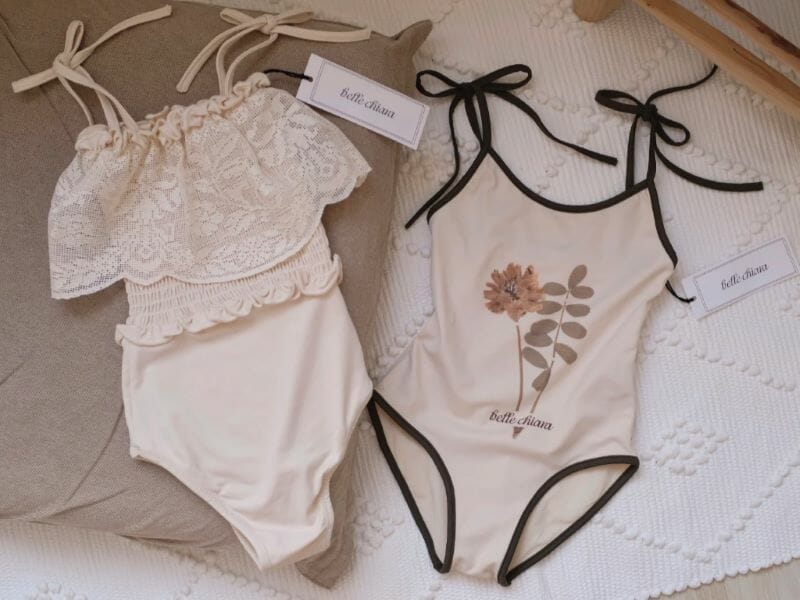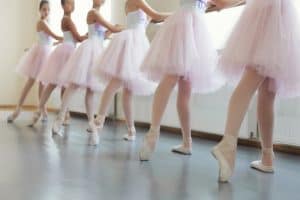Ballet leotards are made from similar and sometimes the same fabric as swimsuits. There are, however, fundamental differences that make us question, can you wear a ballet leotard for swimming? While some happily swim in a ballet leotard, the design is not meant for swimming and could leave your leotard damaged and your body exposed.
Ballet leotards should not be used for swimming. Although the fabrics used for both are similar, leotards are not designed for use in water. Leotards may become discolored, and the stitching could dissolve in chlorinated water. Swimsuits are designed to keep water off the body as much as possible.
Growing up as a ballet girl, I can’t deny that I used my ballet leotard for swimming more than once. The pretty colors, similar fabric, and great fit made it the perfect choice when a real swimsuit wasn’t available. When I look back on these memories, though, I have to admit that my leotards did not make the most comfortable swimsuits. Let’s look into why that is and why it is really not a good idea to use a ballet leotard as a swimsuit.

Can You Wear A Ballet Leotard For Swimming?
If you are asking if you can wear a ballet leotard for swimming, the answer is yes. If you are wondering if you should wear a ballet leotard for swimming, the answer is, unfortunately, no. Ballet leotards look similar to one-piece swimsuits. Most are made with similar fabric and are worn in the same way.
The difference between a swimsuit and a leotard comes with how they are made. Although the two may look similar, leotards are typically made using nylon or spandex. Some leotards are made using soft cotton. Swimsuits are made using a polyester elastane blend. Polyester and elastane are quick-drying fabrics, so it makes sense that they would be used for swimwear.
Looking at what fabric is used to make ballet leotards, we see that they are not designed to keep you dry in the water. In fact, they will fully submerge if placed in water. Furthermore, the dyes and stitching could become damaged in water with chlorine. Since most swimming pools use chlorine for hygiene purposes, your ballet leotard will likely lose its color if you use it in a swimming pool.
From my experience swimming in a ballet leotard, I can also tell you that leotards are a little too thin and clingy for swimming comfortably. Depending on the color of the leotard, it could become somewhat transparent when wet. Black is a better choice than, for instance, pink, but since leotards are made with only one layer, you could still be left revealing a little more than you would like.
Since LYCRA, spandex, and cotton leotards are not intended to keep you dry, the fabric becomes clingy when wet. The water soaks through to your skin almost immediately and sticks to you, showing every curve and line of your body underneath.
Swimsuits, which are made specifically for the water, use fabric that dries quickly. They are often lined with extra material, keeping the swimsuit off your skin and allowing you some privacy while swimming. The fabric does not soak through immediately when submerged in water and so does not cling to your skin as much as a leotard does. This makes for extra comfort and privacy.
Can You Wear A Swimsuit for Ballet?
We may have a solid anti-swimming stance when it comes to wearing a ballet leotard for swimming, so you may be surprised to find us saying that it is acceptable to wear certain swimsuits for ballet or other dance forms.
The fact is that many swimsuits are well-made. They are lined and fit well. They also come in a lovely array of colors and patterns that could make for a lovely sight in a ballet class. Before purchasing or wearing a swimsuit to ballet class, ask your teacher if she permits it and if she has any rules regarding style and color.
Since swimsuits are designed to keep you dry, they work well to keep the sweat from sticking to you as you dance and practice. This is definitely a benefit since not many people enjoy being sweaty for extended periods. The added lining and thicker fabric could also help enhance your body’s beauty while you dance.
When selecting a swimsuit for ballet class, keep in mind that it should fit well. Try a few of your regular steps and movements, including back-bends, forward bends, port de bras, and sauté. Testing your dance moves while wearing the swimsuit you have in mind for the class will allow you to pick up any issues with it.
You could find that the swimsuit rides up at the back or stretches down in the front. It may be a little loose around the armpits and show off more than you would like. Since swimsuits are not explicitly designed for ballet, you will need to ensure that your particular one will work well for your body and your way of moving.
While swimsuits come in one, or two-piece options, the ones most suited to ballet class are one-piece. These closely resemble ballet leotards and are, therefore, more likely to be accepted for class.
What Can I Wear Instead Of A Swimsuit?
If you are about to enjoy some much-needed rest time near water and do not have a swimsuit or have not been able to find one that suits you, you may be wondering what else you can use. While we do not recommend using a ballet leotard as a swimsuit, there are some slightly more suitable alternatives you can try.
When considering alternatives to swimsuits, it is best to take into account your body type, level of confidence, and what activities you will be performing in or around the water. We have come up with a list of helpful ideas. See if any of these are the perfect fit for you. Perhaps they will spark another idea for you.
Our Top Three Alternatives For A Swimsuit
- Board shorts and a tank top. This alternative works well since it looks almost like you are wearing a swimsuit. Many tank tops come with inner support, so they are unlikely to fall off as you swim. Choose to tuck the top in or wear it on the outside of the shorts. Tank tops also have space for a bra if you want to wear one for extra support.
- Maxi dress and sandals. Maxi dresses are so diverse and seem to hide any number of sins. Choose one in a light fabric to avoid overheating. If you want to sun your legs or dip them into the water, simply tie a knot in the bottom, pull the skirt part up through a belt or hold it up.
- Sundress. Sundresses are much like maxi dresses in that they are diverse. A sundress is another good alternative to a swimsuit because it embodies that fun, summer energy we enjoy when near water. Sundresses can be long or short, so consider wearing a shorter version if you are planning to wade into the water.
Conclusion
Ballet leotards are not suitable for use as swimwear. The fabric used to manufacture leotards is water-absorbent, so they become transparent and cling to you as you swim. The chlorine in the water damages the material. This could alter the color of your leotard and cause the stitching to dissolve or stretch slightly.
Swimsuits can be appropriate to wear to ballet class if they fit correctly, and your ballet teacher has given you permission to use one in class. If you are looking for an alternative to a swimsuit, consider a loosely-fitted dress or a pair of shorts with a tank top.




